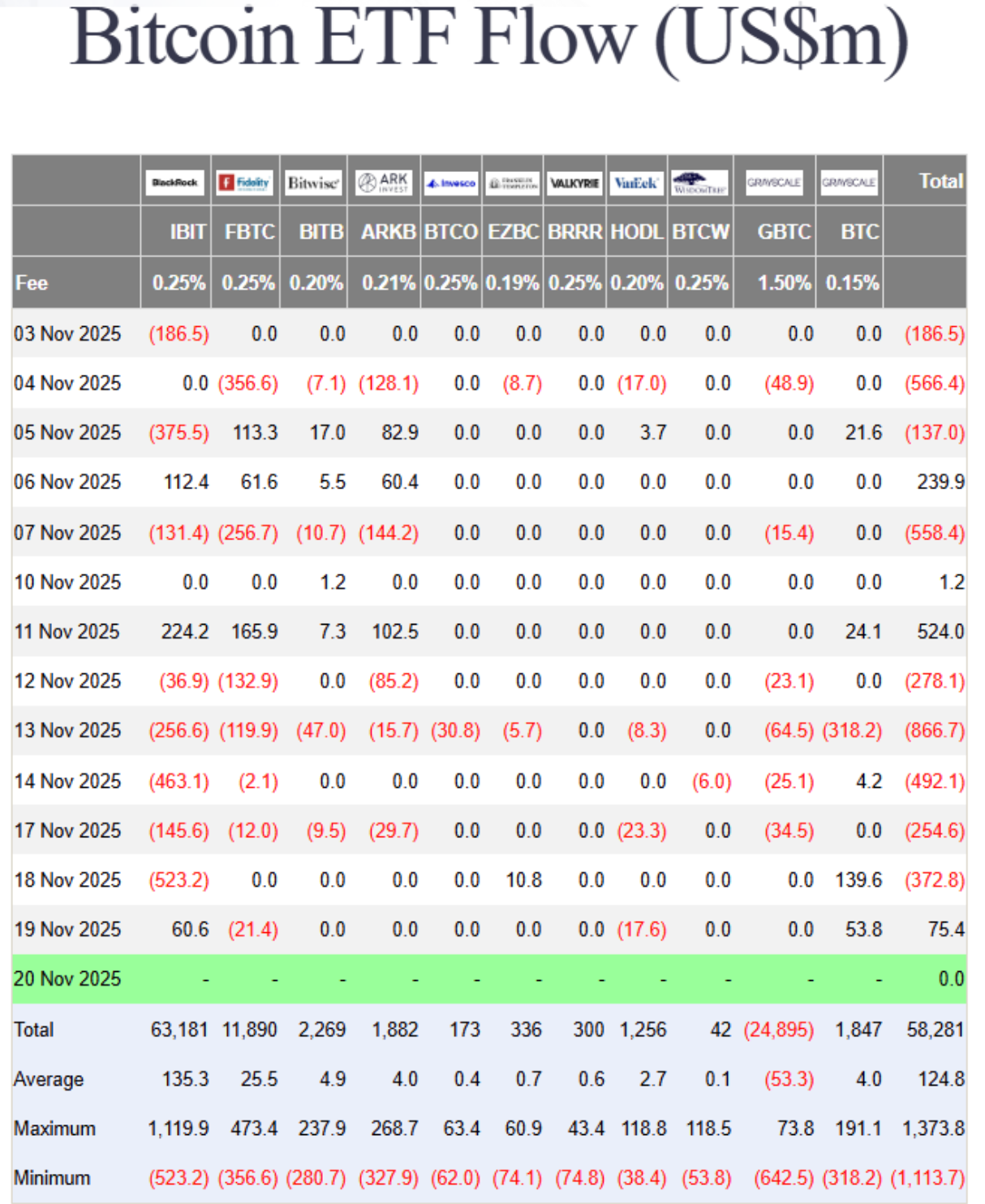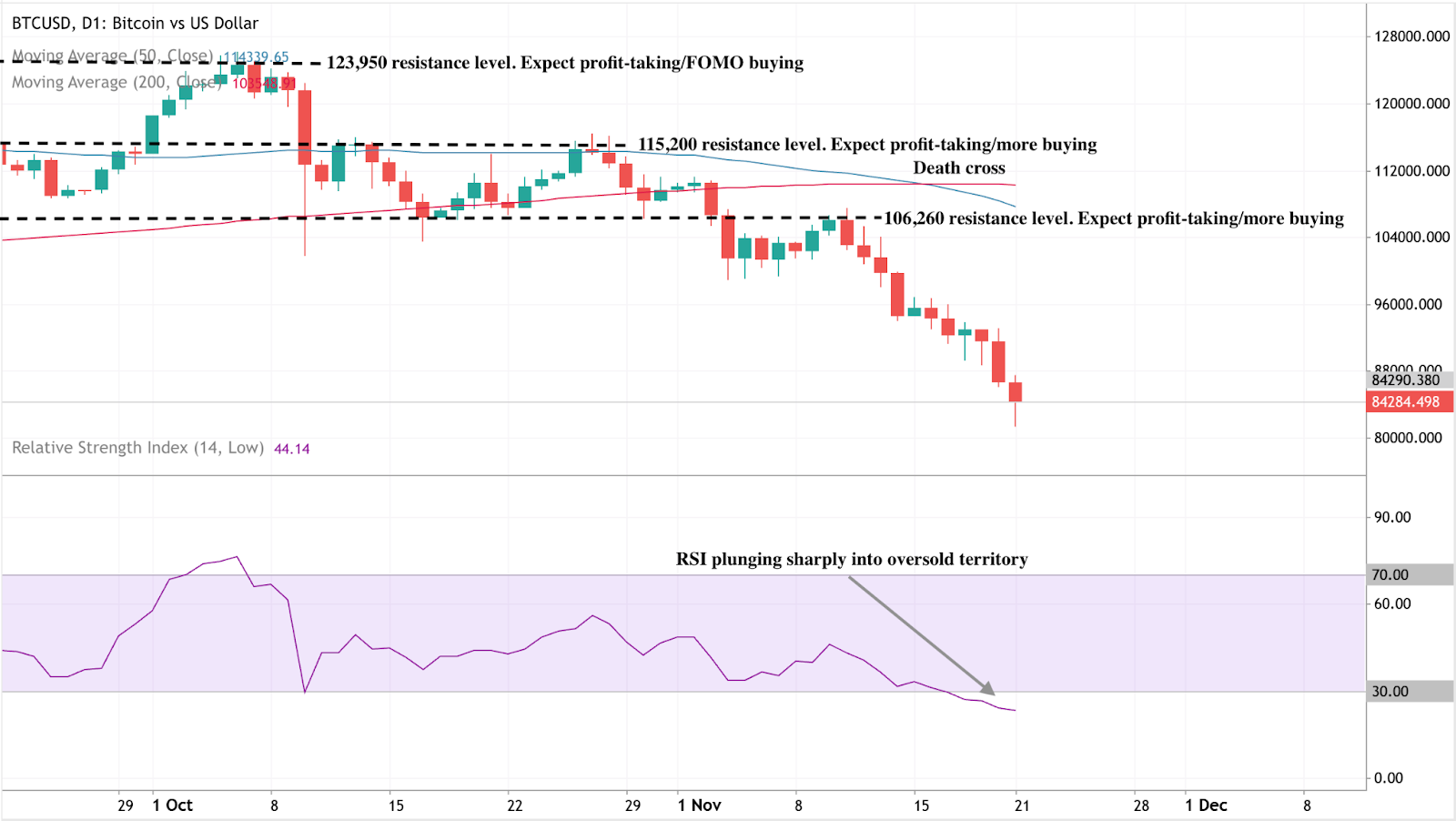A reinicialização severa do Bitcoin: fluxos, medo e duas linhas que importam
.png)
A reinicialização severa do Bitcoin chegou. A maior criptomoeda do mundo perdeu quase um terço de seu valor desde o pico de outubro, caindo para níveis técnicos críticos à medida que as saídas de fundos negociados em bolsa e os obstáculos macroeconômicos entram em vigor.
Dados recentes mostraram que quase 3 bilhões de dólares saíram dos ETFs de Bitcoin somente neste mês, transformando os mesmos fluxos institucionais que antes alimentaram a alta em um ciclo de feedback de resgates e recuos.
Por trás da liquidação está uma mistura de esperanças cada vez menores de redução das taxas do Fed, redução da liquidez e um mercado paralisado pelo “medo extremo”. Com os preços pairando perto de $85.600 e a mínima de um ano em $74.000 se aproximando, a pergunta é simples, mas urgente: essa correção é uma descarga passageira ou o início de uma mudança mais profunda na nova era do ETF do Bitcoin?
O que está impulsionando a correção do Bitcoin
A queda de 30% do Bitcoin não está sendo motivada por escândalo ou choque — é o resultado da reversão final das forças estruturais, de acordo com analistas. Após dois anos de entradas implacáveis, os ETFs spot de Bitcoin agora estão experimentando saídas de capital. Investidores institucionais, antes aclamados como estabilizadores da criptografia, estão mostrando a rapidez com que o sentimento muda quando os mercados oscilam.
De acordo com dados da Farside, os resgates de ETF ocorreram em quase quatro dias deste mês, eliminando quase 3 bilhões de dólares em saídas líquidas.

Parte desse recuo decorre da mudança das condições macro. O da Reserva Federal a relutância em confirmar cortes nas taxas fortaleceu o dólar americano, retirando liquidez dos ativos especulativos.
Movimentos anteriores mostraram que um dólar mais forte normalmente pesa sobre o Bitcoin e, com as leituras de inflação ainda estáveis, os comerciantes estão reavaliando a narrativa do retorno do “dinheiro fácil” em dezembro. O resultado é um mercado em que as altas são enfrentadas com vendas e não com entusiasmo — uma forte mudança da euforia que levou o Bitcoin a $126.000 há apenas algumas semanas.
Por que isso importa
A liquidação do Bitcoin está revelando o quão estreitamente os mercados tradicionais e digitais estão agora interligados. Os ETFs abriram as portas para a exposição institucional, mas também vincularam o Bitcoin a tendências de risco mais amplas. Quando os investidores retiram dinheiro dos produtos de ETF, o efeito ricocheteia tanto nas reservas de liquidez quanto no sentimento.
Como explicou Matt Williams, de Luxor, “A queda para $86.000 é em grande parte impulsionada por forças macro - expectativas de taxas, inflação - e por grandes detentores que cortam a exposição após quebrarem os principais suportes técnicos”.
Para os comerciantes, esse é um ponto de inflexão psicológico. A mesma multidão de varejo que antes inundou as bolsas durante o Dia de Ação de Graças de 2017 - quando o Bitcoin ultrapassou os $10.000 pela primeira vez - está praticamente silenciosa agora.
Dados sociais da Santiment mostram que o sentimento está dividido igualmente entre as previsões de uma queda abaixo de $70.000 e o otimismo selvagem de uma alta para $130.000. A divisão indica indecisão, não convicção. Nessa fase, o medo - não os fundamentos - está dando o tom.

Impacto nos mercados e investidores
A liquidação ultrapassou o espaço criptográfico. A correlação do Bitcoin com índices de ações, como o Nasdaq 100, às vezes subiu acima de 0,8, o que significa que os movimentos em ações de tecnologia e ativos digitais agora se alimentam dos mesmos gatilhos macro. Quando o otimismo das taxas diminui, os dois mercados sofrem. Esse link contraria a afirmação de longa data do Bitcoin como uma proteção contra o risco monetário.
As saídas de ETF são outro ponto de pressão. À medida que os fundos são resgatados, os provedores de liquidez são obrigados a relaxar suas posições nos mercados futuros e à vista, aprofundando assim a volatilidade.
O Crypto Fear & Greed Index, que caiu para 14 nesta semana - o menor desde fevereiro - ressalta a rapidez com que o sentimento se deteriorou. Analistas como Rachael Lucas, da BTC Markets, alertam que as tendências de momentum, fluxo de dinheiro e volume “refletem uma forte deterioração do sentimento”, impulsionada pelo aperto macro e pelo posicionamento de risco.

Em segundo plano, os provedores de liquidez estão com dificuldades. Tom Lee, da Fundstrat, comparou os criadores de mercado de criptomoedas aos “bancos centrais” de liquidez digital — e, no momento, esses bancos estão acabando.
Após a onda de liquidação de 20 bilhões de dólares em outubro, os formadores de mercado estão operando com balanços menores, o que limita sua capacidade de absorver o fluxo de pedidos. É um lembrete de que o encanamento da criptografia, embora mais sofisticado, ainda é frágil.
Perspectiva de especialistas
Os analistas estão divididos entre cautela e curiosidade. Nic Puckrin, do Coin Bureau, descreve o cenário atual como um “cabo de guerra implacável”, com o pessimismo macroeconômico compensado pela resiliência no setor de tecnologia.
Os lucros da Nvidia superaram brevemente o apetite pelo risco, mas o Bitcoin não cumpriu, sugerindo que os traders ainda estão relaxando em vez de recarregar. Puckrin fixa a próxima resistência em $107.500, se uma recuperação puder ganhar força.
Andre Dragosch, da Bitwise, vê paralelos com as correções anteriores no meio do ciclo, observando que a profundidade e a duração desse declínio “permanecem consistentes com as retrações provisórias nos mercados altistas anteriores”. Seu caso base ainda prevê que o ciclo se estenda até 2026, impulsionado pela gradual flexibilização monetária global.
Por enquanto, porém, o risco de curto prazo permanece mais baixo, com $85.600 e $74.000 como os dois níveis críticos a serem observados. Guarde-os e o Bitcoin poderá formar uma base; perca-os e a próxima descarga poderá ser rápida.
Visão geral: o Bitcoin poderia desencadear uma crise financeira?
Apesar do pânico, o Bitcoin permanece relativamente pequeno em comparação com o sistema financeiro real. O mercado total de criptomoedas está em torno de 3 a 4 trilhões de dólares, com o Bitcoin representando cerca de metade. Em contraste, os ativos financeiros globais excedem 400 trilhões de dólares. Colapsos anteriores, como o FTX em 2022 e o Terra em 2021, causaram caos na indústria de criptomoedas, mas quase não se espalharam pelos mercados globais.
Dito isso, cada ciclo aproxima a criptografia das finanças tradicionais. ETFs, participações corporativas e stablecoins apoiados por títulos do Tesouro dos EUA criaram vínculos reais. Uma grave queda do Bitcoin pode desencadear resgates de ETFs, prejudicar os balanços das empresas que detêm BTC e pressionar as stablecoins a liquidar seus ativos do Tesouro. Nada disso causaria uma crise ao estilo de 2008 hoje — mas à medida que a sobreposição cresce, a linha entre “crise criptográfica” e “contágio financeiro” fica mais tênue.
Informações técnicas sobre Bitcoin
No momento em que este artigo foi escrito, o Bitcoin (BTC/USD) estava sendo negociado em torno da marca de $84.200 após uma tendência de baixa prolongada. O RSI mergulhou drasticamente em território de sobrevenda, sinalizando um intenso impulso de baixa e o potencial de um alívio de curto prazo se os compradores intervirem.
Uma cruz mortal - em que a média móvel de 50 dias caiu abaixo da média móvel de 200 dias - reforça a tendência de baixa, sugerindo mais pressão descendente no curto prazo.
Os principais níveis de resistência estão em $106.260, $115.200 e $123.950, onde os comerciantes podem esperar lucros ou juros de compra renovados se ocorrerem tentativas de recuperação. A falha em recuperar essas zonas pode fazer com que o Bitcoin permaneça sob pressão, com o sentimento permanecendo frágil em meio a vendas persistentes.

Principais conclusões
O declínio do Bitcoin não é um acidente — é um teste de estresse de sua nova realidade. A era do ETF aproximou a criptomoeda do sistema financeiro global, para melhor e para pior. A liquidez, antes um vento favorável, agora corta para os dois lados. O medo domina, mas correções profundas fazem parte do DNA do Bitcoin.
Se essas duas linhas - $85.600 e $74.000 - se mantiverem firmes, muitos dizem que essa redefinição pode acabar parecendo apenas mais uma fase de limpeza antes da próxima onda de demanda institucional. Perca-os e a reinicialização severa do Bitcoin poderá se transformar em algo muito mais profundo.
Os números de desempenho citados não são garantia de desempenho futuro.



